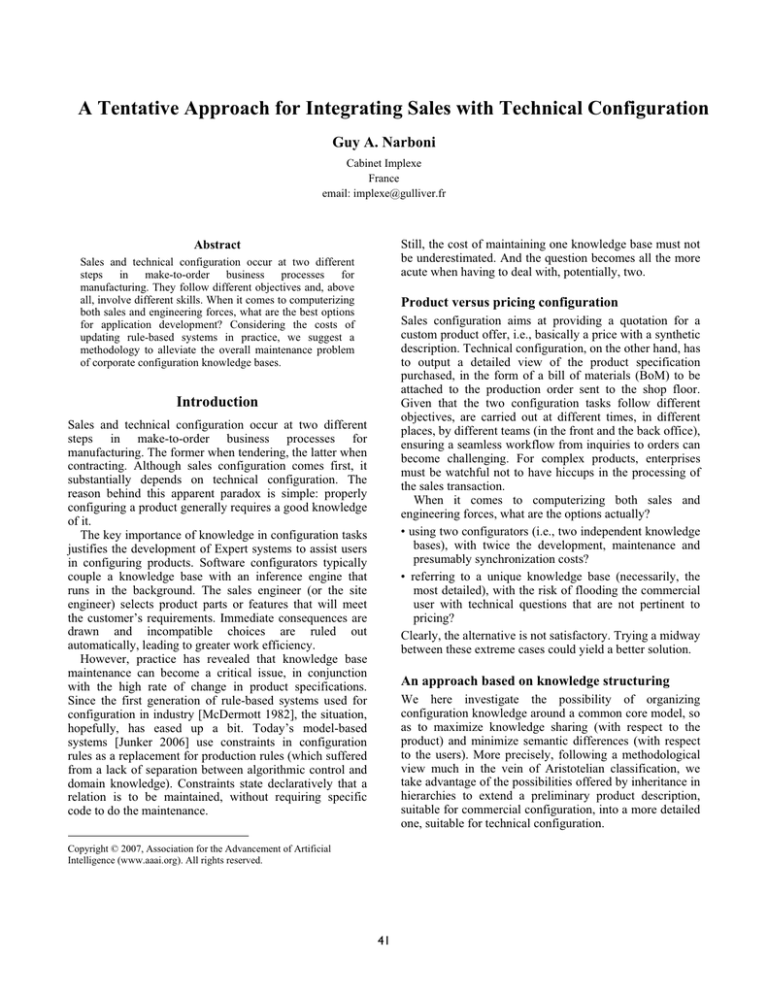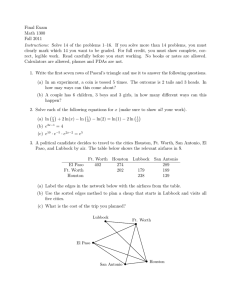
A Tentative Approach for Integrating Sales with Technical Configuration
Guy A. Narboni
Cabinet Implexe
France
email: implexe@gulliver.fr
Still, the cost of maintaining one knowledge base must not
be underestimated. And the question becomes all the more
acute when having to deal with, potentially, two.
Abstract
Sales and technical configuration occur at two different
steps in make-to-order business processes for
manufacturing. They follow different objectives and, above
all, involve different skills. When it comes to computerizing
both sales and engineering forces, what are the best options
for application development? Considering the costs of
updating rule-based systems in practice, we suggest a
methodology to alleviate the overall maintenance problem
of corporate configuration knowledge bases.
Product versus pricing configuration
Sales configuration aims at providing a quotation for a
custom product offer, i.e., basically a price with a synthetic
description. Technical configuration, on the other hand, has
to output a detailed view of the product specification
purchased, in the form of a bill of materials (BoM) to be
attached to the production order sent to the shop floor.
Given that the two configuration tasks follow different
objectives, are carried out at different times, in different
places, by different teams (in the front and the back office),
ensuring a seamless workflow from inquiries to orders can
become challenging. For complex products, enterprises
must be watchful not to have hiccups in the processing of
the sales transaction.
When it comes to computerizing both sales and
engineering forces, what are the options actually?
• using two configurators (i.e., two independent knowledge
bases), with twice the development, maintenance and
presumably synchronization costs?
• referring to a unique knowledge base (necessarily, the
most detailed), with the risk of flooding the commercial
user with technical questions that are not pertinent to
pricing?
Clearly, the alternative is not satisfactory. Trying a midway
between these extreme cases could yield a better solution.
Introduction
Sales and technical configuration occur at two different
steps in make-to-order business processes for
manufacturing. The former when tendering, the latter when
contracting. Although sales configuration comes first, it
substantially depends on technical configuration. The
reason behind this apparent paradox is simple: properly
configuring a product generally requires a good knowledge
of it.
The key importance of knowledge in configuration tasks
justifies the development of Expert systems to assist users
in configuring products. Software configurators typically
couple a knowledge base with an inference engine that
runs in the background. The sales engineer (or the site
engineer) selects product parts or features that will meet
the customer’s requirements. Immediate consequences are
drawn and incompatible choices are ruled out
automatically, leading to greater work efficiency.
However, practice has revealed that knowledge base
maintenance can become a critical issue, in conjunction
with the high rate of change in product specifications.
Since the first generation of rule-based systems used for
configuration in industry [McDermott 1982], the situation,
hopefully, has eased up a bit. Today’s model-based
systems [Junker 2006] use constraints in configuration
rules as a replacement for production rules (which suffered
from a lack of separation between algorithmic control and
domain knowledge). Constraints state declaratively that a
relation is to be maintained, without requiring specific
code to do the maintenance.
An approach based on knowledge structuring
We here investigate the possibility of organizing
configuration knowledge around a common core model, so
as to maximize knowledge sharing (with respect to the
product) and minimize semantic differences (with respect
to the users). More precisely, following a methodological
view much in the vein of Aristotelian classification, we
take advantage of the possibilities offered by inheritance in
hierarchies to extend a preliminary product description,
suitable for commercial configuration, into a more detailed
one, suitable for technical configuration.
Copyright © 2007, Association for the Advancement of Artificial
Intelligence (www.aaai.org). All rights reserved.
41
For exposition, we use the small car configuration example
of [Mittal and Falkerhainer 1990] which involves
reasoning on conditional parts. After slightly restructuring
it and introducing activity variables to explicitly indicate
the participation of a component in the solution, we can
freely distribute configuration rules among the various
chunks of knowledge composing the new base. We then
show, using two constraint models related by a
subsumption ordering (one for sales, one for engineering),
how to significantly reduce the number of solutions when
considering only abstract (commercial) configurations, as
opposed to concrete (technical) ones.
Finally, we recapitulate the assumptions made, list
foreseeable difficulties in the design and management of a
two-level knowledge base, and conclude on the necessary
requirements on tools and technologies for generalizing
this approach to problems of industrial size.
Variables nested in components which are not selected are
not part of the problem and therefore do not have to be
assigned a value.
Note we have slightly changed the formulation by
adding some structure to the original (flat) model, so that
an instance looks closer to a hierarchical bill of materials.
We thus define a car configuration as an edge-labeled tree
of feature-value pairs, like:
Revisiting the car model
There are 14 configuration rules, expressed at the car level.
8 ‘activity constraints1:
Frame se dan
Package s tan dard
Engine
From the point of view of satisfiability, the two
knowledge representations are equivalent [Geller and
Veksler 2005]. Structuring, however, is key to
compositionality and reusability.
The generic product model is described component-wise
(the car, its power sub-system, the air conditioning and
sunroof options). We use a feature matrix to depict it.
•
•
•
•
•
-
Sunroof option included if Package = luxury
Sunroof option included if Package = deluxe
Sunroof option excluded if Frame = convertible
Aircond option included if Package = luxury
Aircond option included if Sunroof.Type = sr1
Aircond option excluded if Engine.Battery = small and
Engine.Size = small
- Sunroof.Opener option included if Sunroof.Type = sr2
- Sunroof.Opener option excluded if Sunroof.Type = sr1
Frame }
Package }
Engine
Si ze
small
Ba ttery small
S ize
}
Ba ttery }
Aircond Ty pe }
Sunroof
Ty pe
Gl ass
6 ’compatibility’ constraints:
}
}
•
•
•
•
Package = standard excludes Frame = convertible
Package = standard excludes Aircond.Type = ac2
Package = luxury excludes Aircond.Type = ac1
Sunroof.Type = sr1 and Aircond.Type = ac2
excludes Sunroof.Glass = tinted
- Sunroof.Opener.Mode = auto and Aircond.Type = ac1 forces
Engine.Battery = med
- Sunroof.Opener.Mode = auto and Aircond.Type = ac2 forces
Engine.Battery = large
Op ener Mode }
Every component definition includes a series of functional
features (parameters, with slots for atomic values) and of
structural features (nested components, within brackets).
The total number of parts is not fixed. Italicized names
denote optional components.
The table below lists the 8 problem variables with their
discrete domains, using dot notation for access paths.
Implicitly, we need 3 additional ’activity’ variables for
controlling the selection of optional parts (booleans).
Variable
Frame
Package
Engine.Size
Engine.Battery
Aircond.Type
Sunroof.Type
Sunroof.Glass
Sunroof.Opener.Mode
Status
required
required
required
required
optional
optional
optional
optional
Domain
{convertible, sedan, hatchback}
{luxury, deluxe, standard}
{small, med, large}
{small, med, large}
{ac1, ac2}
{sr1, sr2}
{tinted, not_tinted}
{auto, manual}
42
The configuration problem boils down to finding a
satisfying assignment. It is easy to see that
Package = luxury
and
Frame = convertible
are
incompatible user choices, whereas the request
Package = luxury and Engine.Size = small has several
solutions.
1
Due to variable clustering, there is no need for the original ’Always
Require Variable’ activity constraints.
• a first half is inherited from a super-class (the genus), to
which the informations of major importance are moved
• the second half contributes to the definition of a sub-class
(the species), which restores the details of minor
importance (the differentiae).
For the concrete product model, nothing is lost in the
process (all structural and behavioural properties, inherited
or supplemented, are enforced). The conjunction of the
definitions of the super-classes now makes up an abstract
model.
Furthermore, based on the class inheritance ordering we
can partially order instances. This corresponds to
subsumption ordering (considering how much information
a solution provides). Intuitively, a technical configuration
should enrich a sales configuration. Indeed, a sales
configuration should specificy the information that must be
preserved in any technical configuration extension.
Let us summarize our working hypotheses at this stage:
1. The sales and engineering views can agree on a
common product model.
2. This pivotal model is the technical configuration model
(which intentionally defines a valid BoM tree, with
constrains in conjunctive form).
3. The technical configuration model is a refinement of the
sales configuration model (which abstracts away
configuration details).
4. The sales configuration model is a relaxation of the
technical configuration model (which implements
necessary but not sufficient conditions)
5. Every technical configuration instance is subsumed by a
sales configuration instance.
6. The atom-valued features of the sales (resp. technical)
configuration model that are made public encompass all
the basic criteria used for expressing functional (resp.
high-level and low-level) requirements.
7. The product knowledge base is organized into a twolevel hierarchy which relates and integrates the two
configuration models.
Adding gradations to knowledge
A general requirement for sales and technical configuration
integration is the following [SAP 2006]:
If you produce complex products, such as industrial
machinery, you particularly need a multilevel product
configuration tool that provides sales with an easy-touse tool to generate preliminary bills of materials
based on customer specifications and provides
engineering with a power-user version to create a
detailed configuration for the final quotation.
Acknowledging the differences in expectations concerning
interactive tools —as well as the differences in product
expertise, we argue that we can make provisions for two
levels of use (for sales representatives and site engineers),
while keeping a unique knowledge base for reference.
Depending on the context, we are used to reason with
different levels of details. Even during technical
configuration, the BoM tree is only developed to a ’macro’
level: the lowest configurable one. Later on, when
collecting detailed information for requirements planning,
BoM items corresponding to composite parts are
deterministically expanded into a ’micro’ list of parts for
creating a production order.
This strict separation of concerns cannot apply when
attempting to draw a boundary between sales and technical
information, for a simple reason: configuration decisions
remain interrelated. No choice can be made in total
isolation. So, the remaining options for setting the right
priorities and lowering the amount of technical details are
twofold:
• information hiding (declare some intricate features
’private’): this idea is easy to implement and preserves
completeness of solving. However, it does not reduce
the model’s complexity (it may indeed obscure its
behaviour).
• information dropping (deactivate part of the conjunctive
constraint net): this is a more radical move which de
facto commands model simplification, at the expense of
completeness. Interestingly though, this approximation
is sound in the sense that the relaxed model will never
reject a technically satisfiable configuration request.
Results
To illustrate our point, we consider that informations of
lower relevance are the car’s battery and sunroof opener.
Since we should not focus on them in the first place, we
provide abstract and detailed descriptions for the classes
Engine and Sunroof. The resulting hierarchy is:
In the sequel, we mainly emphasize this second approach
(a rather trivial ’abstract interpretation’ of the problem’s
constraints), showing how it can be applied in a
conservative way, i.e., without throwing configuration
knowledge away.
Car
Car ’
Methodology
Engine
Engine’
The formalism of order-sorted feature trees [Aït-Kaci
and Podelski 1991] allows us to equip our models with the
declarative inheritance mechanism popularized by objectoriented programming.
Considering a concrete class of component, we can
always split its definition of into two:
Aircond
Sunroof
Opener
43
Sunroof ’
The scaled-down abstract model2 (Car, Engine, Aircond,
Sunroof) allows us to reduce by three fourth the
complexity of the configuration problem.
Model
Variables
Constraints
Solutions
detailed
8+3
14
450
As noted above for implementing this approach,
knowledge editing facilities are more needed than new
runtime solving capabilities. In that respect, a lack of
’knowledge independence’ in a configuration tool can
definitely be spotted as an impediment to large scale
experiments.
relaxed
6+2
9
120
References
Incidently in this case, there is always at least one technical
combination of battery and opener items suitable for
extending a solution to the relaxed model into a solution to
the original problem. Every partial configuration
synthesized is therefore a valid sales configuration that can
be used for an initial quotation.
Aït-Kaci, H., and Podelski, A. 1991. Towards a meaning of
LIFE. In Proceedings of the Third International
Symposium on Programming Language Implementation
and Logic Programming, 255-274.
Junker, U. 2006. Configuration. In Hanbook of Constraint
Programming (Rossi, van Beek and Walsh eds.). Elsevier
B.V.
Mailharro, D. 1998. A classification and constraint based
framework for configuration. Artificial Intelligence for
Engineering Design, Analysis and Manufacturing 12(4):
383-397.
McDermott, J. 1982. R1: A rule-based configurer of
computer systems. Artificial Intelligence 19: 39-88.
Mittal, S. and Falkenhainer, B. 1990. Dynamic constraint
satisfaction problems. In Proceedings of the Eigth National
Conference on Artificial Intelligence (AAAI), 25-32.
Geller, F. and Veksler M. 1995. Assumption-based pruning
in conditional CSP. In Proceedings of the Eleventh
International Conference on Principles and Pratice of
Constraint Programming (CP), 241-255.
SAP 2006. The challenge to achieve perfect order
management. SAP A.G. white paper. www.sap.com
Perspectives
The car example shows that sales configuration (without
involving price calculations) can be viewed as a relaxation
of technical configuration. However, the fact that the
stand-alone sales model maintains configuration
consistency is due to chance. In the general case, a global
validation check would involve running the fully featured
model once, as an oracle, in autonomous mode. Note this
requirement calls for automatic completion capabilities.
Yet, the methodology sketched in this paper does not
require ’on-the-fly’ inheritance mechanisms [Mailharro
1998]. One can always flatten the hierarchy in a preprocessing step. Since each abstracted component has a
unique hier, there is no ambiguity about the concrete type
of parts.
We just claim that a hierarchical decomposition of the
product model should be maintained in the master version
of the configuration knowledge base. This unique source
could be used for generating two variant configurators, for
sales and engineering purposes. Using a single knowledge
base is of vital importance for avoiding the well-known
maintenance bottleneck.
In the real world, decisions for seperating high-level and
low-level knowledge could be more awkward and might
involve a mix of feature hiding and feature relegation. An
upfront investment in knowledge (re-)engineering is
obviously mandatory for properly designing a two-level
configuration model.
For the developer, an immediate positive effect could be
to clarify matters concerning the user-interface definition.
For the end-users of the sales configurator, the expected
benefits should be better acceptance, better understanding
and better performance. For the site engineers finally, it
could avoid misapprehensions in the data handed over, and
consequently facilitate the tracking of customer order
changes.
2
The delta is: minus 1 ternary plus 2 binary variables; minus 3 activity
plus 2 compatibility constraints (marked -).
44





